- info@wildlife-removal.com
Call us for help in your town
Wildlife Removal Education
Dead Animal Removal & Odor Control
Need animal removal in your hometown? We service over 500 USA locations! Click here to hire us in your town and check prices - updated for year 2021.
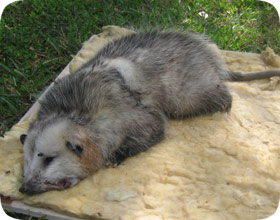 Sometimes the wildlife living inside of homes or buildings dies. The most common complaints include the following:
Sometimes the wildlife living inside of homes or buildings dies. The most common complaints include the following:
- Terrible odor inside home
- Terrible odor outside home
- Presence of swarms of flies
- Concern over health risks
- Stains on ceiling or wall
Click here for a nationwide list of 100's of professional wildlife trappers serving all 50 states.
NUISANCE CONCERNS:
The primary problem with dead animals, of course, is the odor. When an animal dies in the home, it will naturally start to decay. As it does, it gives off organic compound odorant molecules which we detect with our
olefactory sense. The odor may be slight at first, but after about three days after the death of the animal, the odor can be quite strong. The strength of the odor depends on many factors:
Size of Animal: A larger animal means more decaying flesh, which means a stronger odor. A dead possum has a stronger odor than a dead mouse.
Animal Species: Different animals actually have different odors as they decay. Rats are particularly foul, per body weight.
Location of Carcass: This is a big deal. If it dies down a centrally located wall in an area with poor ventilation, watch out. If it dies at the edge of the attic near a ventilated soffit, not so bad.
State of Decomposition: At first the odor is weak, then it grows, then as maggots eat the carcass and the biomass decreases, the odor gradually lessens. The odor life cycle varies, depending on the size of the animal.
Temperature: The dead animal will decompose more quickly at higher temperatures. Furthermore, the dispersal of odor molecules is stronger at higher temperatures - hotter = smellier.
Humidity: Ability to perceive odors is typically heightened at higher humidities.
Air Flow: This is a big deal. Sometimes with a dead animal, people say, "I smell it stronger in the morning" or some variant. It all depends on where the air is flowing. If the dead animal is in the attic,
perhaps as the attic cools off at night, the odor molecules sink down to the house level, but as the attic heats up in the day, the stinky air rises up, and doesn't smell as strong in the house.
Regardless of the exact strength of the odor, most people cannot tolerate the stench caused by a dead animal in the house. Read more about bad smell in house. It's simply very unpleasant, end of story.
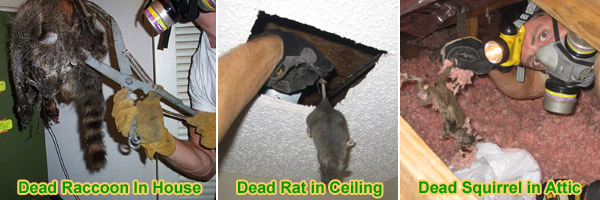
HOW DO I GET RID OF DEAD ANIMALS?
Dead animal removal is sometimes simple, sometimes very difficult, and always dirty. In a simple case, an animal will die somewhere in plain view - such as under a house, in plain sight in the attic, or so on. However,
most of the time, the animal dies in an unknown area - down a wall, in the ductwork, under the insulation, etc. It is our job to find and remove the dead animal, and clean up any residuals (juices, maggots, etc). Some
jobs are incredibly challenging - animals will crawl into the craziest areas - the gap under the bathtub, the gap between the chimney flu and the brick column, in between floors of a home, etc. Wherever it is, we'll find
and remove it, and deodorize the area. It's also important to find the cause of the problem - how did the animal get in? - and take preventative steps to stop the same thing from happening again.
Dead Animal In Attic: It's very common for the wildlife living in your attic to die there. Why die outside where it's cold and wet, when you can do it in the comfort of your own home? When an animal dies
in the attic, most of the smell accumulates in the house. It can be tricky to find it up there, because it might be buried under the insulation. But
persistence always pays off, and I find the critter. Read more about - Dead Animal in Attic.
Dead Animal In Wall: Animals sometimes live in walls or fall down a slick wall and are unable to crawl out. If you don't get them while they're alive and scratching, they die at the bottom of the wall near the
baseboards, or wherever there's a support beam. To find a dead animal in the wall, I sniff and sniff until I find the right spot, then cut a hole to remove the carcass. I always fix the hole afterward. Read more about - Dead Animal in Wall.
Dead Animal In Chimney: This is not terribly common, but it does happen, especially if you've got a slick metal chimney flu that the animals are unable to climb out of. If the animal is in the flu above the
damper, it's not a problem. If they're between metal flues, then it is a big problem.
I sometimes get animals out of the fireplace. Read more about - Dead Animal in Chimney.
Dead Animal In Ducts: People always think the dead body is in the ductwork, but this is rarely the case. It's just that people are confused by the airflow, which stirs up the bad smell.
It's not common for a critter to enter the AC system. Read more about - Dead Animal in Duct or Vent.
Dead Animal Under the House: Yes, raccoons, opossums, and even cats love to live under elevated houses, in the crawl space. They frequently die under there. Because these are larger animals, the smell can last several weeks, even up to two months,
so I recommend that you hire someone like me to crawl under there and bag the animal.
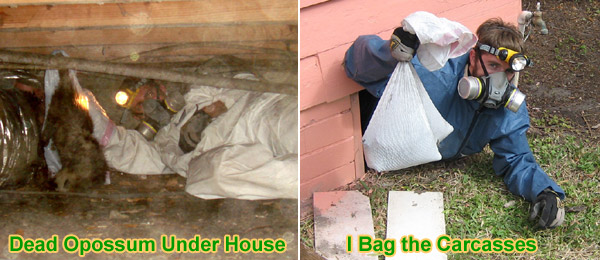
People ask me if I use special equipment to find and remove the dead animals. Well, aside from telescoping inspection mirrors and sometimes a fiber optic scope, and reciprocating saws to cut holes, not really. There is
no special "odor detection machine" that I use to find the deceased wildlife carcasses. My big, fancy tool? - My nose! Yes, I just sniff and sniff, like a dog, right on every wall and ceiling, until I narrow down and
find the source of the odor. That's it! Sometimes it takes a lot of hard work and patience, and most of all,
persistence! I never give up until I find the body. I've got many years of experience, and I understand animal
behavior and building architecture, and I've gotten really good at finding those dead animals. I trust that anyone
that you hire from my national directory will also have the experience and patience to find and remove dead animals.
DEAD ANIMAL DISEASES:
I'm really not an expert in this field. Oftentimes when I remove a dead animal, it's covered with parasites such as fleas, mites, or ticks, and these organisms can carry and transmit disease. Perhaps there's some pathogen
on the dead animal that is harmful. Certainly one should not touch or ingest any part of a dead animal - there's a reason we think stinky things are stinky - it's our body's way of saying "Do not touch. Stay away". I have
reason to believe that a dead animal may potentially pose some health risk in a home, and I always wear full protection - gloves, HEPA gas mask, etc when dealing with dead animal carcasses.
Phoenix Dead Animal Removal -
Los Angeles Dead Animal Removal -
San Diego Dead Animal Removal -
San Jose Dead Removal -
Denver Dead Animal Removal -
Orlando Dead Animal Removal -
Miami Dead Animal Removal -
Jacksonville Dead Animal Removal -
Atlanta Dead Animal -
Chicago Dead Animal Removal -
Baltimore Dead Animal Removal -
Minneapolis Dead Animal Removal -
Charlotte Dead Animal -
Portland Dead Animal -
Philadelphia Dead Animal Removal -
Houston Dead Animal Removal -
Seattle Dead Animal Removal
CLEANUP: After I remove the carcass, I bag it and take it away to be incinerated. I then mop up any juices or maggots, and spray the area down with a special biological cleaner that breaks down the biomass and
stink molecules. All you have to do is let your house air out. Open the windows, and the smell goes away very quickly once the dead animal is gone.
Why did you get a dead animal in your house to begin with? Because you had a live animal in there just a few days ago! You should have addressed the problem of hearing the scratching and running noises in your attic or walls before it
became an even bigger problem of a terrible smell. In most cases in which I remove dead animals, the homeowner ignored a live animal problem. Some people don't do anything until the wires get chewed, or there's a bad smell or something
really bad. So be it. When I remove a dead animal, I also find out how that animal got inside in the first place, and I seal those holes shut, so the problem doesn't happen again!
How Long Can It Take for Dead Animal Odor To Go Away?
In a well ventilated area, it actually doesn’t take very long for the odor of a dead animal to go away. Unfortunately, animals don’t usually die in well ventilated areas. They curl up in nests, which are usually in dark, difficult-to-reach spots, and then they die. It can be weeks before you find the body and, during that time, it will have had the chance to decompose a little bit, in turn, giving off that awful stench that now seems to saturate your home or building. It’s certainly not a pleasant odor.
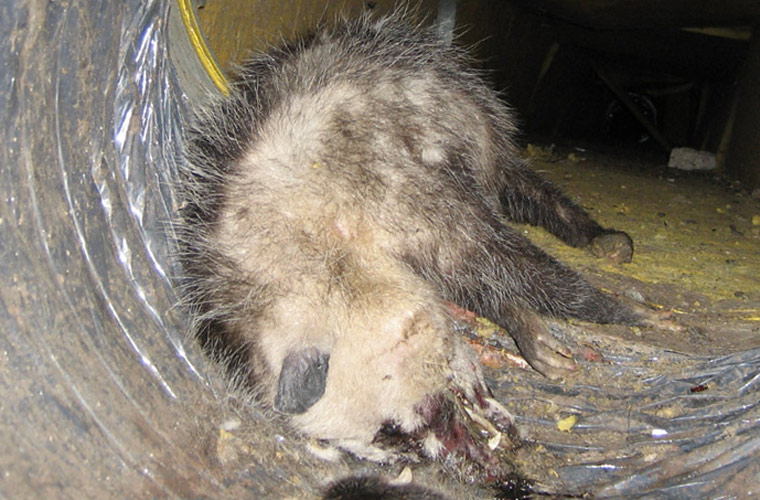
In dark and tight spots, good ventilation doesn’t come easy. This means that you’ll need to get a little inventive with your odor-busting treatments. You are talking about tight, dark, and small spaces, usually with poor ventilation, and this stops you from being able to use many of the cleaning products that you would already have in the cupboard under the sink. If you take a closer look at the label, you’ll see that many of them advise on use in well-ventilated areas only.
If you remove all contaminated material, including the carcass, bedding or nesting material, and others, you may find that a lot of the bad scent disappears along with it. We can’t guarantee removing all of that will solve the problem, on the other hand. This is where your strongest cleaners will come in handy, to clean up fluids, bacteria, and other organisms that are responsible for creating that stench. You can’t just wash down everything using strong biological enzyme cleaners, and wood, attic insulation, and even drywall may need to be entirely replaced. This is obviously not a job that will come cheap, and avoiding it could lead to serious problems later on, and even structural damage to the building if you are not careful.
As a general rule, the wetter the material is, the more it will stink. Although there are a few home remedies that you can turn to, primarily using baking soda and other natural odor-removers, time, good ventilation, and a really deep clean are your best plans of attack.
Go back to the Dead Animal Removal page.
How To Locate A Dead Animal Inside Your House
One of the most frustrating experiences as a home owner is when you have a pungent scent that just won't seem to go away, and when there is a dead animal decomposing somewhere in the house, the smell will often spread throughout the home. There are several steps that you can take to locate the animal and then to remove it from your home, as it can often take several weeks or more, depending on the dead animal, for nature to take its course and for the scent to fade away again.
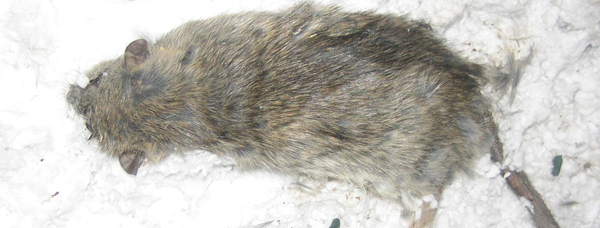
Locate Where the Scent Is Strongest
The first step is to try and get an idea about where in the property that the carcass is located, and the strength of the scent is certainly the best way to do this. While the human nose can help, if you do have any pets, you may have also noticed them being particularly active or scratching around a particular area, which may also give you a hint as to where the carcass may be.
Identify How To Access The Location
In some cases, the dead animal may be in a cellar or an attic where it is relatively easy to collect and remove, but in other situations this can be a lot more challenging. Spaces at the top of the wall cavity, or removable vents can be useful to getting to the carcass, but in some cases there may be no option but to cut a hole in the drywall to get to the location so that the dead animal can be removed.
Bagging And Disposing Of The Carcass
Once you have gained access to the dead animal, try to avoid any contact, as many dead animals will still carry live ticks and other parasites, so wear gloves and long sleeved clothing while moving the carcass. Place it into a thick garbage bag or a plastic container, and then seal it with a second bag to prevent the scent from spreading further. This can then be disposed of in the garbage, or incinerated.
Sealing The Area To Prevent Future Problems
Having removed the carcass, make sure that you clean the area thoroughly, and remove any remaining parts of the animal. It is important to identify how the animal got into the house, and then seal any holes or repair any vents that allowed the animal access to the property in the first place.
How To Find And Remove A Dead Animal
Wild animals generally die from time to time, from sickness, starvation, parasites and predators, or what have you. If they have taken up residence in your house, there is a high likelihood that they will die inside your wall or attic as the case may be. Sick animals most often seek out the comfort of their nest or den. They will instinctively head for a heat source when their body temperature begins to drop.

Due to biological decomposition, animal deaths will naturally be accompanied by an odour, depending on when the animal died. The smell is caused by bacteria and other decomposing microscopic organisms breaking down the body tissue, and is in most cases, the first indication of an animal death in a house or property. Common locations for animal carcasses include the attic, within the house walls, underneath an elevated house, and the yard (in which case a swarm of flies or circling predators overhead would be in order).
The air flow would generally indicate the location of the dead animal on the premise; for instance, if the smell is strongest in the heat of the day, the animal is unlikely to be in the basement. It could be tricky too though, because the odour will be strongest in a room with the least airflow, whether the carcass is close or not. Dead small animals like rats and mice are usually harder to find, even though they smell just as terrible.
To find the location of a dead animal in your home, employ your sense of smell to narrow down the search to the room with the strongest odour. You also need to determine if the dead critter is in the wall or in the attic. You must by now, have eliminated the possibility of it being located under the house (for elevated buildings).
Dead Animal in the wall
- Sniff, sniff, and sniff along the walls in the room until you locate the spot with the strongest smell. In some cases, the dead animal in the wall can be seen whilst looking down from the attic.
- Once you locate the spot, commence removal from the attic if possible, with a grasping tool. If, as in most cases, the carcass is not removable through the attic, you need to cut out a hole in the wall area with a drywall saw
- After finding the carcass, remove it and place in a plastic bag. Ensure that you wear protective rubber gloves to carry out this operation.
- Remove any live maggots from the wall space and spray evenly with an enzyme-based cleaner.
- Incinerate the carcass, or trash them in the case of small rodents.
Dead Animal in the Attic
- Ascertain that the odour is indeed coming from the attic. Then, climb up there and search until you locate it; again follow the smell
- They rarely die out in plain sight. Look under the insulation and the ductwork; you may need to lift up floorboards, and basically look anywhere that a sick animal can crawl into.
- Commence removal and bagging of the carcass once you locate it;
- Clean up and remove all body fluids and biohazardous materials – contaminated faeces, body hair, and droppings
- Remove smaller particles with a powerful vacuum
- Spray with an enzyme-based cleaner and deodorize.
Essential Hygiene Precautions While Removing Dead Animals
- Cover yourself adequately with protective gear before handling any contaminated or suspicious material. The most basic of these are rubber gloves; you should also wear a facial mask, especially at the point of removing the carcass.
- Keep some alcohol gel and tissues handy in case you manage to get any body fluid on your skin in the process of moving the dead animal.
- Be wary of the parasites you have just rendered homeless and wash your clothes as well as yourself with anti-bacterial soap immediately after handling a dead animal.
Go back to the Wildlife Removal home page.


















